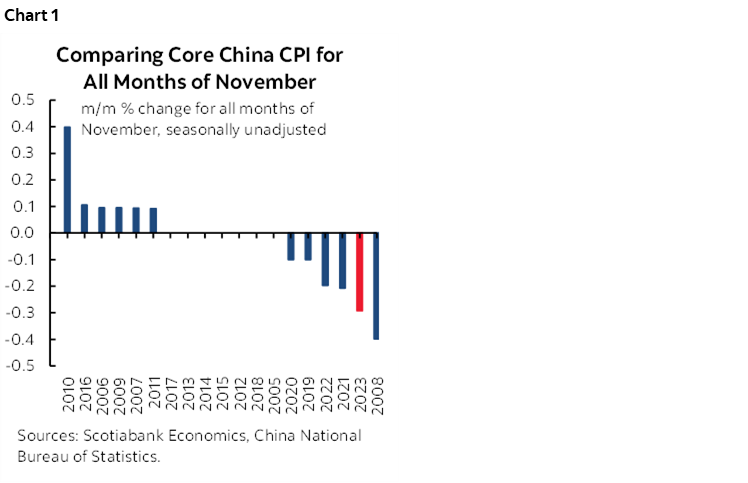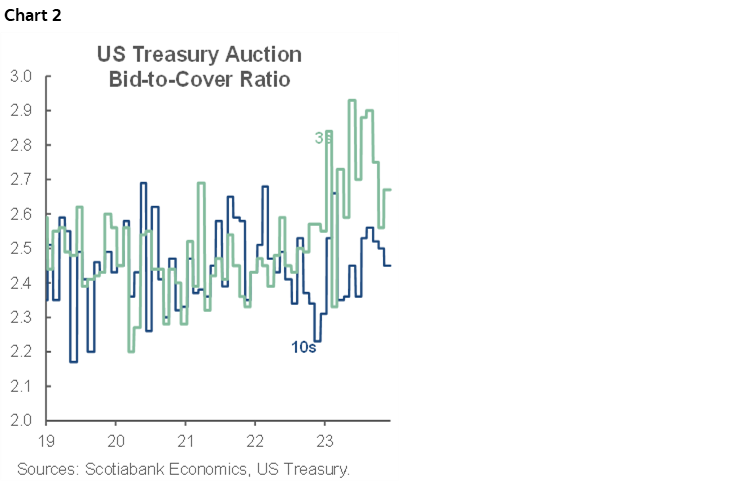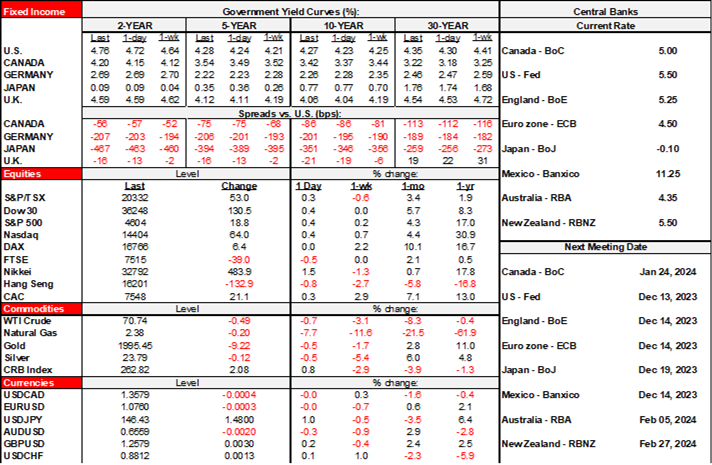ON DECK FOR MONDAY, DECEMBER 11

KEY POINTS:
- Muted risk appetite ahead of a big week for markets
- China CPI: don’t call it deflation
- Yep dips as BoJ speculation pushes back on a December pivot
- Norges Bank likely to hold after CPI was weaker than expected
- US, Canada test appetite for bond auctions today ahead of a key week
- Global Week Ahead—Haste Makes Waste
As a reminder, please see the Global Week Ahead—Haste Makes Waste here in publication format and, for clients, the highlights deck is in your inbox.
A huge week for global central banks and macro data is starting off slowly. Risk appetite is muted ahead of these developments and with limited follow through from Friday’s nonfarm payrolls report (recap here). N.A. stock futures are a touch negative, ditto for European cash markets and Asian equities were mixed with more gainers than decliners. Sovereign bonds are mildly cheaper in the US and there is a slight richening bias across EGBs with nothing much happening across the gilts curve. The dollar is flat on a DXY basis.
China’s inflation rate fell by more than expected last month but don’t call it deflation. CPI was -0.5% y/y (-0.2% consensus). Core CPI was unchanged at +0.6% y/y and -0.3% m/m NSA. Core typically is typically soft in November in seasonally unadjusted terms and this time it was a bit softer than usual (chart 1).

Why not deflation? For starters, the headline softening was driven significantly by lower oil prices last month with a slightly faster rate of decline in food prices. Other categories were soft, but showed little breadth to the decline.
Second, the definition of ‘deflation’ is typically stricter among economists than used by some of the coverage. That definition requires a sustained, economy-wide decline in prices that changes behaviour such that people postpone spending into a future period when prices are expected to be broadly lower. That, in turn, becomes a dangerous downward spiral from which policy may find it difficult to escape. To label China as being in such a situation is highly premature.
We’ll see how the PBOC views this on Thursday when it decides what to do with its 1-year Medium-Term Lending Facility Rate, but almost everyone expects a hold as speculation about another RRR cut is being combined with expectations for further fiscal stimulus into next year on the back of comments following China’s Politburo meeting last week.
The BoJ rollercoaster ride continues. This morning’s rumour mill is leaning against speculation that the BoJ may end negative rates next week. The sources are the usual anonymous folks who point to waiting to see how the Spring wage negotiations proceed. The yen is leading decliners to the USD this morning.
Norway’s CPI was a touch softer than expected ahead of Norges Bank’s decision on Thursday. CPI was up 0.5% m/m SA (0.7% consensus) with underlying inflation down -0.2% m/m (-0.1% consensus). That resulted in a further mild reduction of the market probability of a rate hike this week to nearly zero. Consensus is split with a mild majority of 9 economists expecting a hold and 7 a 25bps hike. The uncertainty stems from the fact that the November 2nd Norges Bank statement said there had been more than expected progress on inflation and that the need for further hikes “depends on economic developments.”
There is nothing terribly notable on tap into the N.A. session. Data wise we’ll only get the NY Fed’s measure of 1-year ahead inflation expectations for November (11amET) after it has been falling from a peak of 6.8% to 3.6% in October. Bond land will take down a US 3s auction (11:30amET) and then a 10-year Treasury notes reopening (1pmET). The pattern to date in bid-to-cover ratios is shown in chart 2 as one measure of auction performance.

Canada also auctions $5.5B of 2s at 12pmET.

DISCLAIMER
This report has been prepared by Scotiabank Economics as a resource for the clients of Scotiabank. Opinions, estimates and projections contained herein are our own as of the date hereof and are subject to change without notice. The information and opinions contained herein have been compiled or arrived at from sources believed reliable but no representation or warranty, express or implied, is made as to their accuracy or completeness. Neither Scotiabank nor any of its officers, directors, partners, employees or affiliates accepts any liability whatsoever for any direct or consequential loss arising from any use of this report or its contents.
These reports are provided to you for informational purposes only. This report is not, and is not constructed as, an offer to sell or solicitation of any offer to buy any financial instrument, nor shall this report be construed as an opinion as to whether you should enter into any swap or trading strategy involving a swap or any other transaction. The information contained in this report is not intended to be, and does not constitute, a recommendation of a swap or trading strategy involving a swap within the meaning of U.S. Commodity Futures Trading Commission Regulation 23.434 and Appendix A thereto. This material is not intended to be individually tailored to your needs or characteristics and should not be viewed as a “call to action” or suggestion that you enter into a swap or trading strategy involving a swap or any other transaction. Scotiabank may engage in transactions in a manner inconsistent with the views discussed this report and may have positions, or be in the process of acquiring or disposing of positions, referred to in this report.
Scotiabank, its affiliates and any of their respective officers, directors and employees may from time to time take positions in currencies, act as managers, co-managers or underwriters of a public offering or act as principals or agents, deal in, own or act as market makers or advisors, brokers or commercial and/or investment bankers in relation to securities or related derivatives. As a result of these actions, Scotiabank may receive remuneration. All Scotiabank products and services are subject to the terms of applicable agreements and local regulations. Officers, directors and employees of Scotiabank and its affiliates may serve as directors of corporations.
Any securities discussed in this report may not be suitable for all investors. Scotiabank recommends that investors independently evaluate any issuer and security discussed in this report, and consult with any advisors they deem necessary prior to making any investment.
This report and all information, opinions and conclusions contained in it are protected by copyright. This information may not be reproduced without the prior express written consent of Scotiabank.
™ Trademark of The Bank of Nova Scotia. Used under license, where applicable.
Scotiabank, together with “Global Banking and Markets”, is a marketing name for the global corporate and investment banking and capital markets businesses of The Bank of Nova Scotia and certain of its affiliates in the countries where they operate, including; Scotiabank Europe plc; Scotiabank (Ireland) Designated Activity Company; Scotiabank Inverlat S.A., Institución de Banca Múltiple, Grupo Financiero Scotiabank Inverlat, Scotia Inverlat Casa de Bolsa, S.A. de C.V., Grupo Financiero Scotiabank Inverlat, Scotia Inverlat Derivados S.A. de C.V. – all members of the Scotiabank group and authorized users of the Scotiabank mark. The Bank of Nova Scotia is incorporated in Canada with limited liability and is authorised and regulated by the Office of the Superintendent of Financial Institutions Canada. The Bank of Nova Scotia is authorized by the UK Prudential Regulation Authority and is subject to regulation by the UK Financial Conduct Authority and limited regulation by the UK Prudential Regulation Authority. Details about the extent of The Bank of Nova Scotia's regulation by the UK Prudential Regulation Authority are available from us on request. Scotiabank Europe plc is authorized by the UK Prudential Regulation Authority and regulated by the UK Financial Conduct Authority and the UK Prudential Regulation Authority.
Scotiabank Inverlat, S.A., Scotia Inverlat Casa de Bolsa, S.A. de C.V, Grupo Financiero Scotiabank Inverlat, and Scotia Inverlat Derivados, S.A. de C.V., are each authorized and regulated by the Mexican financial authorities.
Not all products and services are offered in all jurisdictions. Services described are available in jurisdictions where permitted by law.

